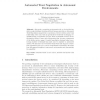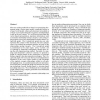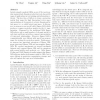35 search results - page 3 / 7 » Computing with words and its relationships with fuzzistics |
CORR
2002
Springer
13 years 7 months ago
2002
Springer
The first morphological learner based upon the theory of Whole Word Morphology (Ford et al., 1997) is outlined, and preliminary evaluation results are presented. The program, Whol...
IWSOS
2007
Springer
14 years 1 months ago
2007
Springer
Autonomic computing environments rely on devices that are able to make intelligent decisions without human supervision. Automated Trust Negotiation supports the cooperation of devi...
AAIM
2006
Springer
14 years 1 months ago
2006
Springer
In this note we deal with sensitivity analysis of combinatorial optimization problems and its fundamental term, the tolerance. For three classes of objective functions (Σ, Π, MA...
ACSC
2009
IEEE
14 years 2 months ago
2009
IEEE
Most text mining methods are based on representing documents using a vector space model, commonly known as a bag of word model, where each document is modeled as a linear vector r...
SDM
2011
SIAM
12 years 10 months ago
2011
SIAM
Latent semantic analysis (LSA), as one of the most popular unsupervised dimension reduction tools, has a wide range of applications in text mining and information retrieval. The k...



